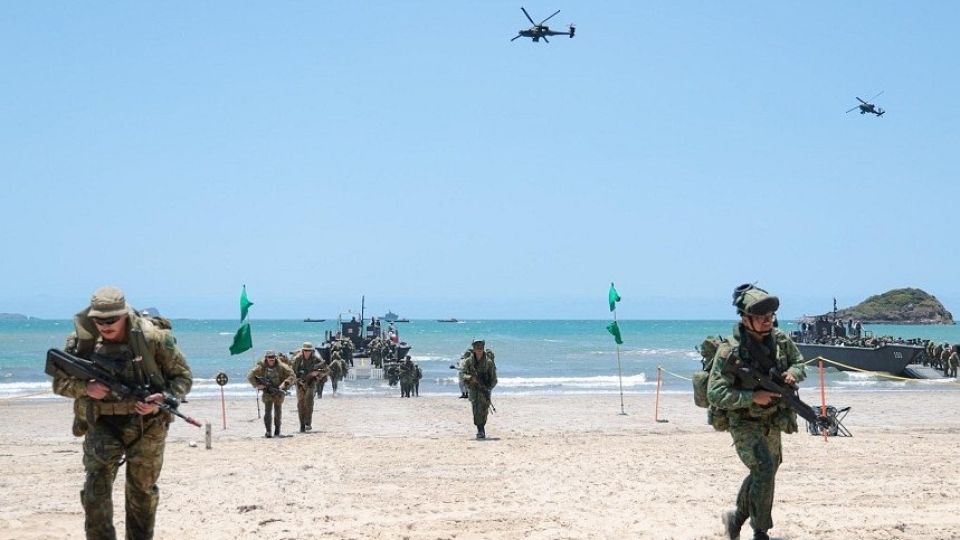November 11, 2024
SHOALWATER BAY TRAINING AREA – More than 1,900 personnel from the Singaporean and Australian forces are conducting a joint military exercise that will see soldiers from both countries coming ashore from ships before assaulting objectives inland.
Codenamed Exercise Trident, the training activity involves troops and vehicles being disgorged from the Republic of Singapore Navy’s (RSN) landing ship tanks (LSTs), RSS Endurance and RSS Persistence, and then ferried ashore using fast craft utility (FCU) and fast craft equipment and personnel (FCEP).
Overhead, Republic of Singapore Air Force’s (RSAF) CH-47F and H225M helicopters will be ferrying more troops ashore for the duration of the exercise, with AH-64D Apache attack helicopters providing air support and Heron I unmanned aircraft keeping watch over the proceedings and looking out for enemy movements.
This year’s Exercise Trident, which is taking place at the Shoalwater Bay Training Area (SWBTA) in Australia from Nov 6 to Nov 15, marks the first time in the exercise that participants will conduct assaults in jungle terrain and an urban setting.
In the first profile, Singapore Armed Forces (SAF) and Australian Defence Force (ADF) troops will be ferried inland to a pre-determined landing zone on RSAF transport helicopters before an assault on a jungle objective occupied by the enemy.
This will be followed by further landing of troops on the beach at Freshwater Bay located within the training area, where they will be ferried on vehicles to assault an urban objective farther inland. This element will be resupplied by sea using the Lighter Amphibious Resupply Cargo 5-ton wheeled amphibious vehicles of the 3rd SAF Transport Battalion.
During a visit to the exercise, The Straits Times observed Singaporean and Australian troops pouring out of several FCUs at the beach, and later experienced a ride in a Chinook helicopter, which travelled together with another helicopter carrying more troops from the RSS Persistence to a landing zone inland.
Senior Lieutenant-Colonel Enriquez Michael Zachary, the lead of the SAF contingent at the exercise, said that Exercise Trident was an opportunity for the SAF to train in an amphibious exercise at a scale, complexity and level of realism that was difficult to replicate in Singapore.
“The vast training area here allows us to do contiguous manoeuvres, we can land troops on the beach and move inland and involve personnel in all four (SAF) services at the same time,” he said.
The Singapore Army troops at Exercise Trident are from the 3rd Battalion Singapore Guards commanded by Lieutenant-Colonel Mohamad Fahrul Saaid, who told the media that a key objective of the exercise was to improve interoperability with the Australians.
The Australian soldiers at this year’s exercise are from the Australian Army’s 5th Battalion, Royal Australian Regiment, with a platoon of Australians embedded with an SAF company of Guardsmen, while a platoon of Singaporeans will move the other way to join the Australians for the duration of the exercise.
“It is also an opportunity to give my soldiers the confidence to conduct operations from fast craft in choppy waters,” said LTC Fahrul, referring to the rougher waters found off the SWBTA, compared with Singapore waters.
The opportunity to operate in more challenging sea conditions was also highlighted by Major Daniel Hu, the commander of the LST RSS Persistence.
“Back in Singapore, the water conditions are a lot more benign than they are here, and being able to overcome the challenge posed by the winds and the sea would enable our personnel to better hone their skills,” he said, referring to the RSN’s sailors and operators of the FCEPs and FCUs.
The lack of civilian air and maritime traffic around the SWBTA also means the SAF is able to perform complex missions involving multiple assets without being concerned about getting in the way of commercial aircraft and ships, MAJ Hu said.
The RSN has deployed 650 personnel to the exercise along with the two LSTs, split roughly evenly between active personnel and NSmen.
On the sidelines of the exercise, defence scientists from the Defence Ministry’s Future Systems and Technology Directorate and DSO National Laboratories partnered the Australian Defence Department’s Defence Science and Technology Group to conduct science and technology demonstrations.
The scientists deployed an integrated network of unmanned aerial and ground vehicles as well as a tactical 5G communications network at the urban operations training facility in SWBTA to support SAF and ADF’s urban operations for the first time.
The autonomous vehicles also provided 3D terrain mapping simultaneously to both SAF and ADF personnel at high speed, high bandwidth and low latency.

